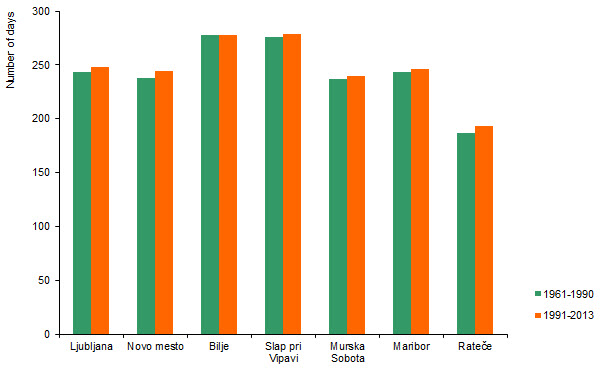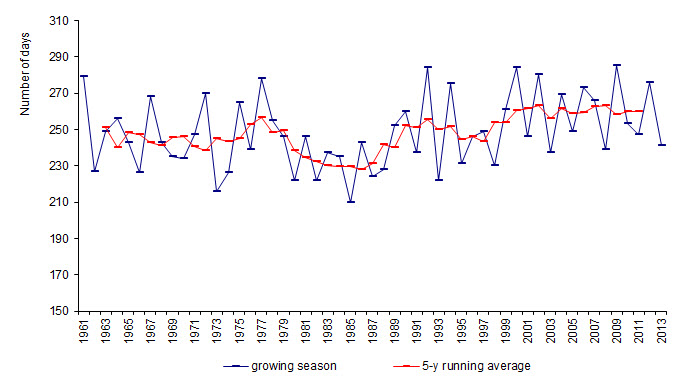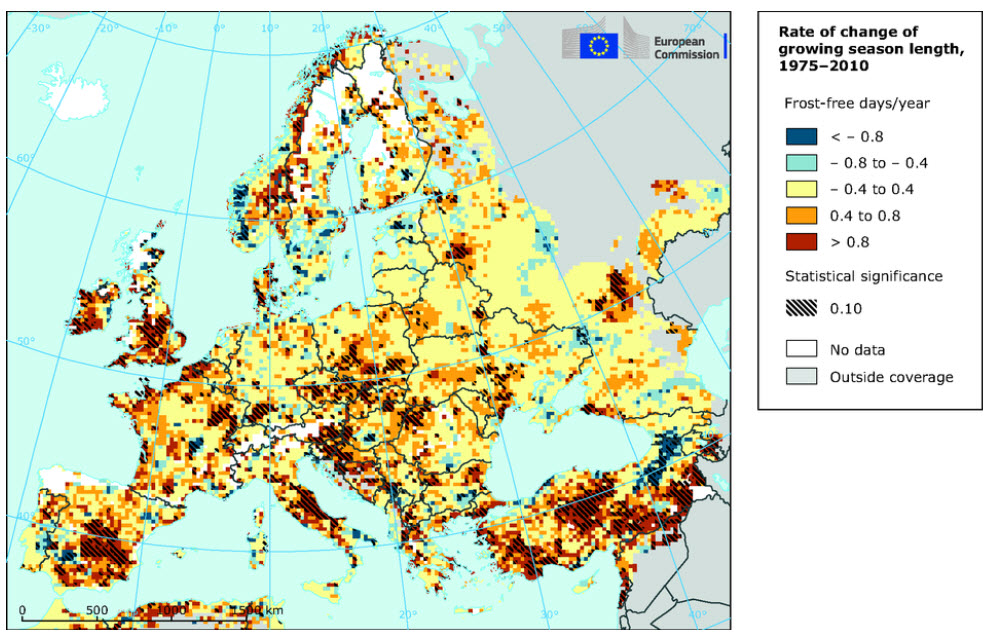[PP06] Annual growing season length

Key message

Annual growing season has lengthed throughout most of central and southern Spain, central Italy, Atlantic coast, British Isles, Denmark and Central Europe (also in Slovenia). Projections of the growing season point out further increase all over the Europe, mainly because of an earlier start in the spring growing season and its subsequent end in autumn. Lengthening of the annual growing season will northward expansion of warm-season crops.
Definition
Indicator shows average annual growing season length in Slovenia (1961-1990 and 1991–2013), changes in average annual growing season length in Ljubljana (1961-2011) and changes of the average annual growing season length of agricultural crops in Europe (1975-2010). As changing air temperature significantly affect the duration of the growing season indicator presents important data set for monitoring climate change in Slovenia.
The length of the annual growing season is the period between the day when the average daily air temperature in spring exceeds the temperature threshold of 5°C and the day when it drops below this value in autumn.
The air temperature of 5°C is generally recognised as the lowest temperature threshold for plant vegetation. The length of annual growing season is defined by the temperature threshold of 5°C and the temperature threshold so determined is used as one of the conditions for the classification of agro-ecological zones.
Charts
Archive of Meteorological Data, Slovenian Environment Agency, 2014
| Ljubljana | Novo mesto | Bilje | Slap pri Vipavi | Murska Sobota | Maribor | Rateče | ||
|---|---|---|---|---|---|---|---|---|
| 1961-1990 | number of days | 243 | 238 | 278 | 276 | 237 | 243 | 187 |
| 1991-2013 | number of days | 248 | 244 | 278 | 279 | 240 | 246 | 193 |
Archive of Meteorological Data, Slovenian Environment Agency,2014
| 1961 | 1962 | 1963 | 1964 | 1965 | 1966 | 1967 | 1968 | 1969 | 1970 | ||
|---|---|---|---|---|---|---|---|---|---|---|---|
| growing season | number of days | 279 | 227 | 249 | 256 | 243 | 226 | 268 | 243 | 235 | 234 |
| 1971 | 1972 | 1973 | 1974 | 1975 | 1976 | 1977 | 1978 | 1979 | 1980 | ||
| growing season | number of days | 247 | 270 | 216 | 226 | 265 | 239 | 278 | 255 | 246 | 222 |
| 1981 | 1982 | 1983 | 1984 | 1985 | 1986 | 1987 | 1988 | 1989 | 1990 | ||
| growing season | number of days | 246 | 222 | 237 | 235 | 210 | 243 | 224 | 228 | 252 | 260 |
| 1991 | 1992 | 1993 | 1994 | 1995 | 1996 | 1997 | 1998 | 1999 | 2000 | ||
| growing season | number of days | 237 | 284 | 222 | 275 | 231 | 246 | 249 | 230 | 261 | 284 |
| 2001 | 2002 | 2003 | 2004 | 2005 | 2006 | 2007 | 2008 | 2009 | 2010 | ||
| growing season | number of days | 246 | 280 | 237 | 269 | 249 | 273 | 266 | 239 | 285 | 253 |
| 2011 | 2012 | 2013 | |||||||||
| growing season | number of days | 247 | 276 | 241 |
EEA, Growing season for agricultural crops (CLIM 030), 2012
http://www.eea.europa.eu/data-and-maps/indicators/growing-season-for-agricultural-crops-1/assessment
Goals
- To estimate the effect of climate changes on plant development.
- Preparation of adaptation procedures for the newly arising climatic conditions and mitigation of possible adverse effects.











